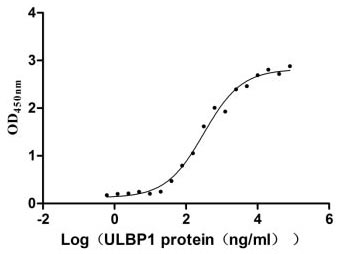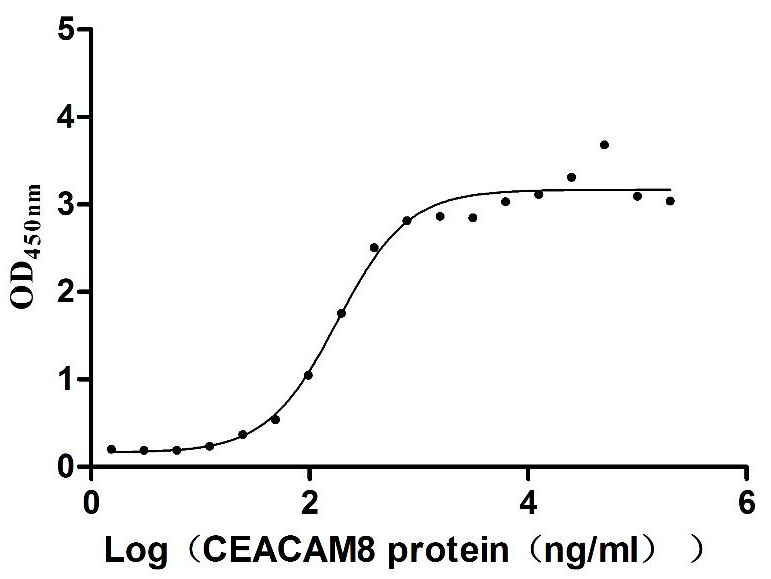Recombinant Rat ATP-sensitive inward rectifier potassium channel 10 (Kcnj10)
Promotion-
中文名稱:大鼠Kcnj10重組蛋白
-
貨號:CSB-CF012048RA
-
規(guī)格:¥9720
-
促銷:
-
圖片:
-
其他:
產(chǎn)品詳情
-
純度:Greater than 85% as determined by SDS-PAGE.
-
基因名:Kcnj10
-
Uniprot No.:
-
種屬:Rattus norvegicus (Rat)
-
蛋白長度:Full Length
-
來源:in vitro E.coli expression system
-
分子量:48.5 kDa
-
表達區(qū)域:1-379aa
-
氨基酸序列MTSVAKVYYSQTTQTESRPLVAPGIRRRRVLTKDGRSNVRMEHIADKRFLYLKDLWTTFIDMQWRYKLLLFSATFAGTWFLFGVVWYLVAVAHGDLLELGPPANHTPCVVQVHTLTGAFLFSLESQTTIGYGFRYISEECPLAIVLLIAQLVLTTILEIFITGTFLAKIARPKKRAETIRFSQHAVVAYHNGKLCLMIRVANMRKSLLIGCQVTGKLLQTHQTKEGENIRLNQVNVTFQVDTASDSPFLILPLTFYHVVDETSPLKDLPLRSGEGDFELVLILSGTVESTSATCQVRTSYLPEEILWGYEFTPAISLSASGKYVADFSLFDQVVKVASPGGLRDSTVRYGDPEKLKLEESLREQAEKEGSALSVRISNV
Note: The complete sequence including tag sequence, target protein sequence and linker sequence could be provided upon request. -
蛋白標(biāo)簽:N-terminal 10xHis-tagged
-
產(chǎn)品提供形式:Liquid or Lyophilized powder
Note: We will preferentially ship the format that we have in stock, however, if you have any special requirement for the format, please remark your requirement when placing the order, we will prepare according to your demand. -
緩沖液:If the delivery form is liquid, the default storage buffer is Tris/PBS-based buffer, 5%-50% glycerol. If the delivery form is lyophilized powder, the buffer before lyophilization is Tris/PBS-based buffer, 6% Trehalose.
-
復(fù)溶:We recommend that this vial be briefly centrifuged prior to opening to bring the contents to the bottom. Please reconstitute protein in deionized sterile water to a concentration of 0.1-1.0 mg/mL.We recommend to add 5-50% of glycerol (final concentration) and aliquot for long-term storage at -20℃/-80℃. Our default final concentration of glycerol is 50%. Customers could use it as reference.
-
儲存條件:Store at -20°C/-80°C upon receipt, aliquoting is necessary for mutiple use. Avoid repeated freeze-thaw cycles.
-
保質(zhì)期:The shelf life is related to many factors, storage state, buffer ingredients, storage temperature and the stability of the protein itself.
Generally, the shelf life of liquid form is 6 months at -20°C/-80°C. The shelf life of lyophilized form is 12 months at -20°C/-80°C. -
貨期:Delivery time may differ from different purchasing way or location, please kindly consult your local distributors for specific delivery time.
-
注意事項:Repeated freezing and thawing is not recommended. Store working aliquots at 4°C for up to one week.
-
Datasheet & COA:Please contact us to get it.
相關(guān)產(chǎn)品
靶點詳情
-
功能:May be responsible for potassium buffering action of glial cells in the brain. Inward rectifier potassium channels are characterized by a greater tendency to allow potassium to flow into the cell rather than out of it. Their voltage dependence is regulated by the concentration of extracellular potassium; as external potassium is raised, the voltage range of the channel opening shifts to more positive voltages. The inward rectification is mainly due to the blockage of outward current by internal magnesium. Can be blocked by extracellular barium and cesium. In the kidney, together with KCNJ16, mediates basolateral K(+) recycling in distal tubules; this process is critical for Na(+) reabsorption at the tubules.
-
基因功能參考文獻:
- H3K9me2 and G9a are sensitive to epileptic seizure activity during the acute phase of epilepsy and can affect the transcriptional regulation of the Kcnj10 (Kir4.1) channel. PMID: 29115470
- studies suggest that AGE-modification of laminin is detrimental to Kir4.1 channels. By studying the role of AGEs in Kir4.1 channels we have identified a novel mechanism of Muller cell dysfunction and its subsequent involvement in Diabetic retinopathy. PMID: 29474462
- IL-1beta promotes the proliferation of cultured astrocytes by influencing the expression of Kir4.1. PMID: 28395711
- Kir4.1 channels possess a diurnal rhythm, and this rhythm is dampened with diabetes, thereby suggesting that the increase in TNF-alpha is detrimental to normal Kir4.1 rhythm and expression. PMID: 28460049
- This study demonstrated changes in Kir4.1 expression in an animal model of PTS in the acute and chronic stages of the condition. PMID: 26768400
- This study demonstrated that Kir4.1 developmental expression both in the cortex and hippocampus and support the glial role of Kir4.1 in K(+) spatial buffering. PMID: 26427731
- data suggest that G83V, L166Q, and Q212R residues play a pivotal role in controlling Kir4.1 channel function. PMID: 26867573
- Data suggest that lipopolysaccharide (LPS)-induced downregulation of inwardly rectifying K(+) channel Kir4.1 mRNA in cultured astrocytes might be related with the inflammatory cytokine IL-1beta. PMID: 26927380
- Over-activation of NMDA receptors is a primary cause of the reduction of Kir4.1 expression in CNS disorders associated with increased exposure to glutamate. PMID: 25451797
- Ependymal cells and tanycytes differentially operate Kir4.1 and AQP4 actively to control the property of fluids at local areas in the brain. PMID: 25380566
- This study demonistrated that the epigenetic regulation of Kir4.1, a glial-specific K+ channel, known to be essential for normal CNS development. PMID: 24415225
- The present results suggest that reduced activity of astrocytic Kir4.1 channels in the amygdala is involved in limbic hyperexcitability in NERs. PMID: 23603404
- Decreased expression of Kir4.1 is observed in the brainstem and cortex from rats in an amyotrophic lateral sclerosis model. PMID: 22987392
- An uncoupling expression of AQP4 and Kir4.1 on astrocytic end feet is partly responsible for mediation of cytotoxic edema following subarachnoid hemorrhage. PMID: 22420318
- Kir4.1 channels in satellite glial cells are suppressed during trigeminal inflammatory pain. PMID: 21680091
- Pigment epithelium-derived factor acts as an antioxidative agent against the decrease in Kir4.1 expression in retinal Muller cells in diabetic conditions. PMID: 22266516
- down-regulation of Kir4.1 may mediate distinct aspects of Glutamine-induced astrocytic dysfunction in hepatic encephalopathy. PMID: 21538466
- Astrocytes in the CA1 region of the hippocampus are progressively depolarized following cerebral ischemia coinciding with decreased potassium channel Kir4.1 protein expression in glial cells. PMID: 20833221
- Heteromeric Kir4.1-Kir5.1 channels confer pH sensitivity to retrotrapezoid nucleus astrocytes. PMID: 20926613
- Data show that all Kir4.1 mutations compromised channel function, but the underlying mechanisms were different. PMID: 20807765
- CaR decreases cell surface expression of Kir4.1 channels via a mechanism that involves Galpha(q) and caveolin. PMID: 21084311
- These results indicate the differential loss of KIR4.1 channel function among SeSAME syndrome mutations. PMID: 20678478
- In adult rats, Kir4.1 expression is reduced by nearly 80% following crush spinal cord injury. PMID: 20375134
- data suggest the signals on the COOH terminus of Kir4.1 potassium channel determine the intracellular localization of Kir5.1 potassium channel/Kir4.1 heteromer in distal tubules PMID: 15292049
- Results demonstrate that variations (T262S and R271C) in the gene encoding Kir4.1 do not produce any observable changes in channel function or in predicted channel structure. PMID: 15936844
- disruption of the carboxyl-terminal PDZ-binding motif induced mostly clustered distribution but did not reduce whole-cell channel activity PMID: 16033858
- Kir4.1 channels are primarily responsible for significant hyperpolarization of cortical astrocytes and are likely to play a major role in potassium buffering. Significant inhibition of glutamate clearance in astrocytes with knock-down of Kir4.1 occurs. PMID: 17091490
- Modulation of the Kcnj10 channel by multiple neuotransmitters via Galphaq-coupled receptors is reported. PMID: 17559083
- Regional differences in astrocytic expression of Kir4.1 channels result in marked changes in potassium clearance rates in these two regions of the spinal cord. PMID: 17581847
- While confirming similar properties of glial Kir and recombinant Kir4.1, the results also suggest mechanisms underlying K+ buffering in glial cells. PMID: 18293411
- These results demonstrate that the phosphorylation-dependent scaffolding of the basolateral K(+) channels by MAGI-1a-long participates in the renal regulation of the fluid and electrolyte homeostasis. PMID: 18303016
- Silencing Kir4.1 in the trigeminal ganglion using RNA interference (RNAi) results in a reversible change in nociceptive threshold and nociceptive-related behavior. PMID: 18417695
顯示更多
收起更多
-
亞細胞定位:Membrane; Multi-pass membrane protein. Basolateral cell membrane.
-
蛋白家族:Inward rectifier-type potassium channel (TC 1.A.2.1) family, KCNJ10 subfamily
-
組織特異性:Predominantly expressed in the brain, including in glial cells of the cerebellum and forebrain. Expressed at lower levels in the kidney, and other peripheral tissues.
-
數(shù)據(jù)庫鏈接:
Most popular with customers
-
Recombinant Human UL16-binding protein 1 (ULBP1) (Active)
Express system: Mammalian cell
Species: Homo sapiens (Human)
-
Recombinant Human T-cell surface protein tactile (CD96), partial (Active)
Express system: Mammalian cell
Species: Homo sapiens (Human)
-
Recombinant Human Carcinoembryonic antigen-related cell adhesion molecule 6 (CEACAM6) (Active)
Express system: Mammalian cell
Species: Homo sapiens (Human)
-
Recombinant Human Desmoglein-2 (DSG2), partial (Active)
Express system: Mammalian cell
Species: Homo sapiens (Human)
-
Express system: Mammalian cell
Species: Homo sapiens (Human)





-AC1.jpg)













